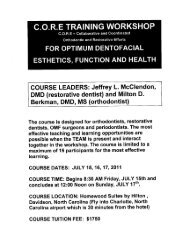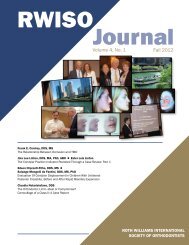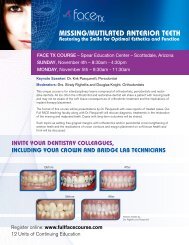2010 RWISO Journal - Roth Williams International Society of ...
2010 RWISO Journal - Roth Williams International Society of ...
2010 RWISO Journal - Roth Williams International Society of ...
Create successful ePaper yourself
Turn your PDF publications into a flip-book with our unique Google optimized e-Paper software.
Figure 4 Patient with gingival recession due to orthodontic<br />
treatment in the presence <strong>of</strong> an undiagnosed severe skeletal<br />
transverse discrepancy. Note minimal alveolar bone on<br />
the buccal surface <strong>of</strong> the maxillary molars.<br />
<strong>of</strong> Wilson and nonworking interferences would be beneficial<br />
for adult patients who are periodontally at risk, and might<br />
prophylactically reduce the risk for younger patients.<br />
Transverse Deficiency and the Airway<br />
Ricketts’ description <strong>of</strong> “adenoid facies” 24 also suggests a relationship<br />
between a constricted nasopharyngeal airway and<br />
a narrow maxilla. Ricketts states children with any impairment<br />
<strong>of</strong> the nasal passages become predominantly mouth<br />
breathers. Since the tongue is positioned in the floor <strong>of</strong> the<br />
mouth to allow airflow, it cannot provide support to shape<br />
the developing palate; thus pressure from the circumoral<br />
musculature acts unopposed. The palate is narrowed, and<br />
an exaggerated curve <strong>of</strong> Wilson develops upon tooth eruption.<br />
Because the tongue is positioned low in the mouth, the<br />
patient may also develop a retruded, high-angle mandibular<br />
shape, which can increase the risk for sleep apnea. 25 An example<br />
<strong>of</strong> adenoid facies is shown in Figure 5.<br />
Figure 5 A teenager who had nasopharyngeal airway impairment<br />
during growth and development. The images show the facial,<br />
dental, skeletal, and airway presentation upon growth cessation.<br />
In one recent study, 26 patients with transverse deficien-<br />
cies due to a narrow maxilla who were treated with rapid<br />
palatal expansion, showed an increase <strong>of</strong> 8% to 10% in the<br />
volume <strong>of</strong> the upper airway. In another study, 27 patients with<br />
dental posterior crossbites who were treated with palatal expansion<br />
also showed an increase in the volume <strong>of</strong> the upper<br />
airway. Oliveria de Felippe, et al28 found that palatal expansion<br />
decreased nasal resistance and improved nasal breathing.<br />
While additional research in this area is certainly needed,<br />
the current literature suggests that any improvement in the<br />
volume <strong>of</strong> the airway, as an effect <strong>of</strong> palatal expansion to<br />
optimize the transverse dimension <strong>of</strong> the jaws, may greatly<br />
benefit overall growth and development.<br />
Methods <strong>of</strong> Transverse Diagnosis<br />
With a transverse deficiency due to a narrow maxilla, the<br />
temporomandibular joints, musculature, periodontal tissue,<br />
and airway can be adversely affected in the susceptible patient.<br />
Our goal as orthodontists should be to develop skeletal<br />
relationships and a functional occlusion that are as close to<br />
optimal as possible, to lessen the role that any discrepancies<br />
<strong>of</strong> the occlusion would play in exacerbating the detrimental<br />
effects to the joints, periodontium, or dentition. In order<br />
to achieve this a correct skeletal and dental diagnosis in all<br />
three planes <strong>of</strong> space is mandatory.<br />
In this section, we present three different methods for<br />
diagnosing the transverse dimension—one using traditional<br />
cephalometry, one using dental casts, and one using conebeam<br />
CT (computed tomography). We do not endorse any<br />
one <strong>of</strong> these methods over the others; our purpose here is<br />
simply to describe all three methods, so that readers will be<br />
able to incorporate a transverse skeletal diagnosis into their<br />
practice, no matter what level <strong>of</strong> technology is available.<br />
Regardless <strong>of</strong> which <strong>of</strong> these methods one chooses, the doctor<br />
must keep optimal treatment goals in mind as a rationale for<br />
normalizing the transverse dimension (Figures 6 and 7).<br />
Figure 6 Goals for normalizing the transverse dimension.<br />
<strong>RWISO</strong> <strong>Journal</strong> | September <strong>2010</strong><br />
13








